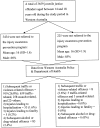Effect of an injury awareness education program on risk-taking behaviors and injuries in juvenile justice offenders: a retrospective cohort study
- PMID: 22355394
- PMCID: PMC3280207
- DOI: 10.1371/journal.pone.0031776
Effect of an injury awareness education program on risk-taking behaviors and injuries in juvenile justice offenders: a retrospective cohort study
Abstract
Background: Risk-taking behavior is a leading cause of injury and death amongst young people.
Methodology and principal findings: This was a retrospective cohort study on the effectiveness of a 1-day youth injury awareness education program (Prevent Alcohol and Risk-related Trauma in Youth, P.A.R.T.Y.) program in reducing risk taking behaviors and injuries of juvenille justice offenders in Western Australia. Of the 3659 juvenile justice offenders convicted by the court magistrates between 2006 and 2010, 225 were referred to the P.A.R.T.Y. education program. In a before and after survey of these 225 participants, a significant proportion of them stated that they were more receptive to modifying their risk-taking behavior (21% before vs. 57% after). Using data from the Western Australia Police and Department of Health, the incidence of subsequent offences and injuries of all juvenile justice offenders was assessed. The incidence of subsequent traffic or violence-related offences was significantly lower for those who had attended the program compared to those who did not (3.6% vs. 26.8%; absolute risk reduction [ARR] = 23.2%, 95% confidence interval [CI] 19.9%-25.8%; number needed to benefit = 4.3, 95%CI 3.9-5.1; p = 0.001), as were injuries leading to hospitalization (0% vs. 1.6% including 0.2% fatality; ARR = 1.6%, 95%CI 1.2%-2.1%) and alcohol or drug-related offences (0% vs. 2.4%; ARR 2.4%, 95%CI 1.9%-2.9%). In the multivariate analysis, only P.A.R.T.Y. education program attendance (odds ratio [OR] 0.10, 95%CI 0.05-0.21) and a higher socioeconomic background (OR 0.97 per decile increment in Index of Relative Socioeconomic Advantage and Disadvantage, 95%CI 0.93-0.99) were associated with a lower risk of subsequent traffic or violence-related offences.
Significance: Participation in an injury education program involving real-life trauma scenarios was associated with a reduced subsequent risk of committing violence- or traffic-related offences, injuries, and death for juvenille justice offenders.
Conflict of interest statement
Figures
References
-
- Eldridge D. Injury among young Australians. AIHW 2008 May, Bulletin. 60
-
- AIHW. Mortality over the twentieth century in Australia: Trends and patterns in major causes of death. Mortality Surveillance Series no. 4. AIHW cat. no. PHE73. Canberra: AIHW; 2005.
-
- Chapman A, D L Rosman DL. Measuring road crash injury severity in Western Australia using ICISS methodology. Available: http://www.cycle-helmets.com/injury-severity.pdf. Accessed 2011, August 22.
-
- Honeybul S, Ho KM, Lind CR, Gillett GR. Observed versus predicted outcome for decompressive craniectomy: a population-based study. J Neurotrauma. 2010;27:1225–1232. - PubMed
-
- Honeybul S, Ho KM, Lind CR, Corcoran T, Gillett GR. The retrospective application of a prediction model to patients who have had a decompressive craniectomy for trauma. J Neurotrauma. 2009;26:2179–2183. - PubMed
Publication types
MeSH terms
Grants and funding
LinkOut - more resources
Full Text Sources
Medical



